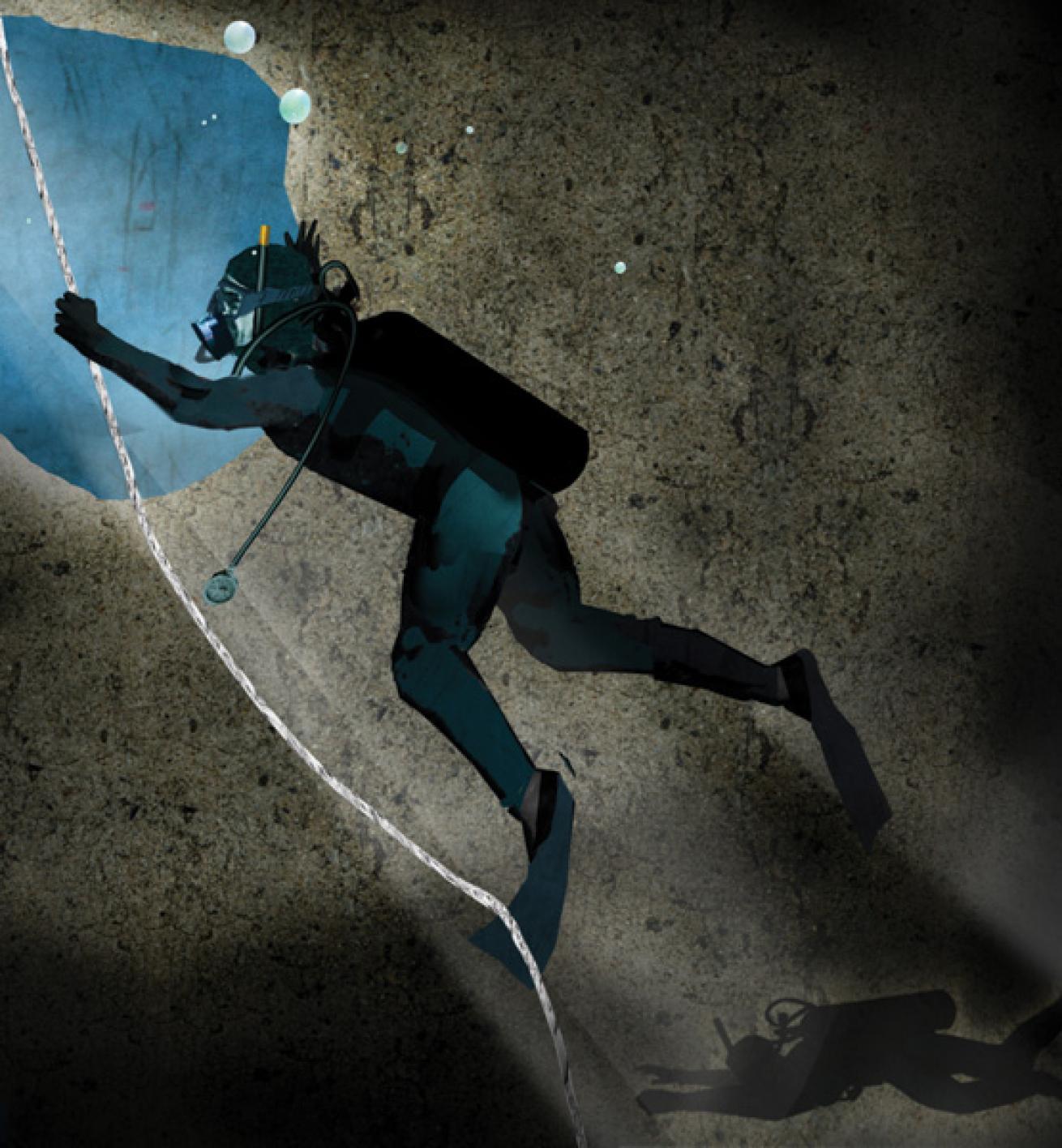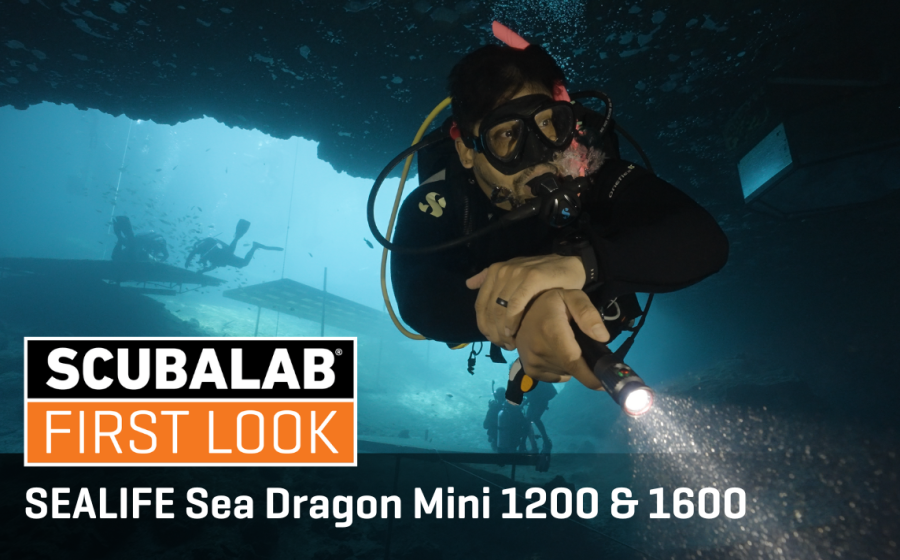Lessons for Life: Split Decision

Lessons for Life: Split Decision
Michael Morgenstern
The choice Tim was about to make wasn’t easy. In order to get help, he would have to leave his buddy behind while cave diving. Knowing he was between a rock and a hard place, Tim turned and left Tonya back in the cave and quickly made his way toward the surface.
The Divers
Tim and Tonya were experienced cave divers, and they loved exploring virgin cave systems. Even when they dived systems they knew very well, they loved the thrill of diving places most divers would never see. They also appreciated the technical nature of the dives: the equipment, the planning, the preparation. Cave diving for them was as much a mental exercise as a physical one.
The Dive
The cave system they planned to dive was one they had dived many times before. Still, Tim and Tonya planned the dive thoroughly. They knew that there are no shortcuts when cave diving, where there's no direct access to the surface.
On this day, they decided to explore a secondary cave system neither had been through before, and agreed on the times and gas pressures they would use to turn the dive and head back to the entrance.
They planned to complete the dive using staged oxygen cylinders in the open area of the spring. They could rest and let the oxygen help them off-gas the built-up nitrogen. They also planned for 30 minutes of required decompression before they could safely surface — even outside the cave, they were faced with a ceiling that prevented them from surfacing.
Before they entered the cave system, Tim and Tonya carried their oxygen cylinders into the water and tucked them away behind a log just outside the cave mouth so they would be ready when they completed the dive.
The Accident
Tim and Tonya completed their exploration and turned to head back. They had pushed deeper into the cave system than ever before, but they were well within their dive plan when they began working their way back toward the surface.
Everything was going perfectly. They moved back into the main chamber of the cave and were back on the permanently fixed line that would guide them toward the surface. Tonya finished reeling in the exploration line they had connected to the permanent line. Tim knew it would be at least another 30 minutes before they’d exit the cave and complete their decompression. He took the lead, careful to stay off the silty bottom. They were swimming, but also allowed the gentle flow of the water to carry them forward.
Tim turned to check on Tonya, but realized she wasn’t behind him. He turned and began searching for her. He found Tonya a few minutes later, floating just off the bottom. Her regulator was out of her mouth and there was no sign she was breathing.
When Tim looked toward the exit and realized how far he would have to swim, carrying Tonya with him, he knew there was no way he’d ever make it. He had to leave Tonya behind and swim to get help.
Analysis
We’ll never know what overcame Tonya, just that she drowned in a cave while making an exit. Regardless of what caused the accident, Tim was faced with a difficult situation. He had to leave a friend behind in the water to save himself. If he had been able to bring Tonya directly to the surface, she might have been helped. It took him 10 minutes to swim to the mouth of the cave, exit and ascend to the surface. Swimming with another diver in tow would no doubt have taken longer. Tim skipped his own required decompression, and was hit with decompression sickness in the process. He was treated at a hyperbaric chamber and made a full recovery.
In many instances, technical diving involves diving in an overhead environment. Any time you can’t make a direct ascent to the surface at any time during the dive, there are additional risks and precautions that come with it. Entering a cave, penetrating a wreck or making a planned decompression dive where you cannot safely ascend to the surface requires a different mind-set and additional training.
In the case of Tim and Tonya, neither did anything wrong (with the exception of Tim’s direct ascent to the surface). His action did nothing to save Tonya. She might have had a heart condition, an aneurysm or another medical problem that caused her to lose consciousness.
Remember: Diving beyond recreational limits comes with its own set of rules; you have to change the way you think to be able to make those dives.
Lessons for Life
1. Maintain personal fitness for the dives you’re doing.
2. Establish an emergency-action plan and discuss it with your buddy. Make sure everyone in the dive group understands the conditions you will be diving in.
3. Practice emergency drills. Be mentally prepared to handle a problem before it becomes an emergency.
4. Seek specialized training before entering overhead environments and understand the risks.
Eric Douglas co-authored the book Scuba Diving Safety, and has written a series of dive-adventure novels and short stories. Check out his website at www.booksbyeric.com.

Michael Morgenstern
The choice Tim was about to make wasn’t easy. In order to get help, he would have to leave his buddy behind while cave diving. Knowing he was between a rock and a hard place, Tim turned and left Tonya back in the cave and quickly made his way toward the surface.
The Divers
Tim and Tonya were experienced cave divers, and they loved exploring virgin cave systems. Even when they dived systems they knew very well, they loved the thrill of diving places most divers would never see. They also appreciated the technical nature of the dives: the equipment, the planning, the preparation. Cave diving for them was as much a mental exercise as a physical one.
The Dive
The cave system they planned to dive was one they had dived many times before. Still, Tim and Tonya planned the dive thoroughly. They knew that there are no shortcuts when cave diving, where there's no direct access to the surface.
On this day, they decided to explore a secondary cave system neither had been through before, and agreed on the times and gas pressures they would use to turn the dive and head back to the entrance.
They planned to complete the dive using staged oxygen cylinders in the open area of the spring. They could rest and let the oxygen help them off-gas the built-up nitrogen. They also planned for 30 minutes of required decompression before they could safely surface — even outside the cave, they were faced with a ceiling that prevented them from surfacing.
Before they entered the cave system, Tim and Tonya carried their oxygen cylinders into the water and tucked them away behind a log just outside the cave mouth so they would be ready when they completed the dive.
The Accident
Tim and Tonya completed their exploration and turned to head back. They had pushed deeper into the cave system than ever before, but they were well within their dive plan when they began working their way back toward the surface.
Everything was going perfectly. They moved back into the main chamber of the cave and were back on the permanently fixed line that would guide them toward the surface. Tonya finished reeling in the exploration line they had connected to the permanent line. Tim knew it would be at least another 30 minutes before they’d exit the cave and complete their decompression. He took the lead, careful to stay off the silty bottom. They were swimming, but also allowed the gentle flow of the water to carry them forward.
Tim turned to check on Tonya, but realized she wasn’t behind him. He turned and began searching for her. He found Tonya a few minutes later, floating just off the bottom. Her regulator was out of her mouth and there was no sign she was breathing.
When Tim looked toward the exit and realized how far he would have to swim, carrying Tonya with him, he knew there was no way he’d ever make it. He had to leave Tonya behind and swim to get help.
Analysis
We’ll never know what overcame Tonya, just that she drowned in a cave while making an exit. Regardless of what caused the accident, Tim was faced with a difficult situation. He had to leave a friend behind in the water to save himself. If he had been able to bring Tonya directly to the surface, she might have been helped. It took him 10 minutes to swim to the mouth of the cave, exit and ascend to the surface. Swimming with another diver in tow would no doubt have taken longer. Tim skipped his own required decompression, and was hit with decompression sickness in the process. He was treated at a hyperbaric chamber and made a full recovery.
In many instances, technical diving involves diving in an overhead environment. Any time you can’t make a direct ascent to the surface at any time during the dive, there are additional risks and precautions that come with it. Entering a cave, penetrating a wreck or making a planned decompression dive where you cannot safely ascend to the surface requires a different mind-set and additional training.
In the case of Tim and Tonya, neither did anything wrong (with the exception of Tim’s direct ascent to the surface). His action did nothing to save Tonya. She might have had a heart condition, an aneurysm or another medical problem that caused her to lose consciousness.
Remember: Diving beyond recreational limits comes with its own set of rules; you have to change the way you think to be able to make those dives.
Lessons for Life
1. Maintain personal fitness for the dives you’re doing.
2. Establish an emergency-action plan and discuss it with your buddy. Make sure everyone in the dive group understands the conditions you will be diving in.
3. Practice emergency drills. Be mentally prepared to handle a problem before it becomes an emergency.
4. Seek specialized training before entering overhead environments and understand the risks.
Eric Douglas co-authored the book Scuba Diving Safety, and has written a series of dive-adventure novels and short stories. Check out his website at www.booksbyeric.com.










